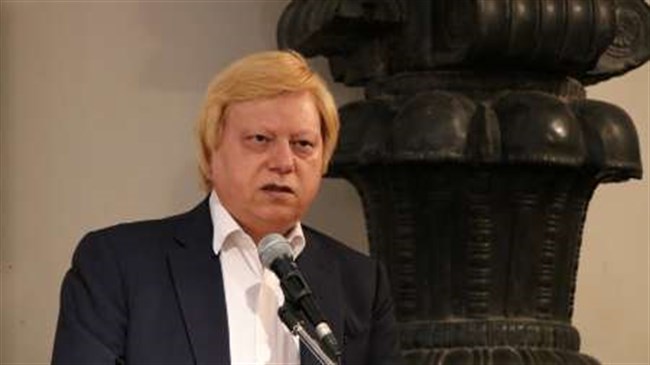
Mohammad Beheshti, who was speaking at the 11th meeting of 'Where Is Iran, Who Is the Iranian' at the Planning and Budget Organization, noted that unlike the Zionist lobby, they would need no conspiracy and definition of common interests rather the lobby would be totally natural and effective in bringing Iran out of global isolation in cultural terms, IRNA wrote.
He added, "The Iranian community, despite having independent existence, has attachment to the homeland and it is not indifferent to it and could serve as a bridge for reestablishing global interactions."
He pointed to the Alborz Mountains as barrier to the movement of clouds from the Caspian Sea towards the Iranian plateau, and said, "We consider the Central and the Lut deserts as the two stigmas in our homeland and the evidence of this is our treatment of this land over the past 100 years."
Defining the economy as a collection of resources providing an optimum product, he said when something becomes a single entity, all the components together find a new aspect to make it optimum.
Underlining that nothing in a single entity is accidental, he said by changing one element in a single entity, all the components would collapse since all the components are related to the whole.
Beheshti stated that the single entity has a single cause and pointed to the existence of the two huge continents on the Planet Earth in about 600 million years ago and said the movement of these two continents has brought about transformation of the Earth because of which today there are several continents and even India has been separated from South Africa and attached to Asia and due to its pressure on the Asian continent the Himalayan Mountains have come into existence.
Iran, he said, had been composed of three pieces that were compressed naturally and constantly by the movements and pressures of other layers, including Eurasia and the Arabian Peninsula, adding that Iran is compressed about 23mm to 30mm per year which reduces its span but adds to its height.
Pointing out that Iran is located in the middle of the world, Beheshti said, "By looking at history, we see that Iran has been on the pathway of the main conquests in the world, and for this reason, for example, Alexander had to cross Iran in order to reach the West. However, given the situation of Iran, when Alexander crossed this country he was accused by his commanders of being an Iranian."
He noted that the Central Desert slows down the speed so much that people entering this land are affected by our cultural integration.
When the Arabs reached Khorasan, the Abbasid Caliphate was formed which turned out to be Iranian, he added.
Elsewhere in his remarks, Beheshti referred to the Mongol invasion of Iran, and said, "When the Mongols arrived in Tabriz, they decided to remain in that land and were forced to let Iranians take control of administrative affairs."
He added, "The Mongols invaded Iran in 609, and Soltanieh was built in 709, while in a hectare of decorations under the ceiling of the building, there is not a single mention of the Mongols which shows how the Mongols passed through Iranian integration."
Referring to the existence of natural unity along with natural diversity in Iran, he said the integrity in this land strengthens the relation between diversity and unity with each reinforcing the other.
Turning to the continuity of civilizational periods in Iran, he said, "Egypt is a very ancient country, but the ancient Egypt (the pharaohs) was almost cut off by Cambyses, and until the Fatimid dynasty (about a thousand years later), and its aftermath, we see no brilliant civilization in that land."
The ancient Greek civilization collapsed after the invasion of the Macedonian Philip whereas in Iran the continuity of civilizational periods could be observed up to the Qajar era.
Underlining the existence of a cultural unit in Iran, he said, "For this reason, 'Shahnameh' is respected by all Iranians and they give the names mentioned in 'Shahnameh' to their children, they know their stories and generalize the geography of the 'Shahnameh' with their own geography."
Beheshti referred to the Persian language and Norouz ceremonies as the signs of cultural unity and said, "Wherever Norouz is celebrated, 'Shahnameh' is respected or the Persian poetry is composed, that place is Iran."
There are 12,000 poets in Bosnia who compose Persian poems, he said referring to the influence of Iranian culture in that country.
Cultural unity is not possible in the absence of cultural diversity, he said stressing that both should be present together and pointed out that about 20 to 60 languages and 70,000 dialects being spoken in Iran which he said are indicative of the cultural diversity of the country.
He said cultural diversity in Iran is of intrinsic origin and noted that sometimes, some mistakenly compare cultural diversity in Iran with the cultural diversity of Canada and Australia, and use terms such as the country of forty pieces, while they ignore the fact that in the US and in Canada, cultural diversity has been brought from outside with the arrival of people from other lands, while the Kurds and the Turks became Kurds and Turks in Iran.
Referring to the common origins of Kurds and Turks, he added, "The origin of both these people is the Medes. In fact, those who inhabited the plains were the Turks while the inhabitants of the mountains were the Kurds, and because of their different positions and roles, they have different characteristics.
"History shows that whenever Iran was involved in global interactions, it underwent a thriving economic and cultural period, but with the decline in those interactions, we have been stricken by cultural depression and because of isolation we remain unaware of world events."

Add new comment